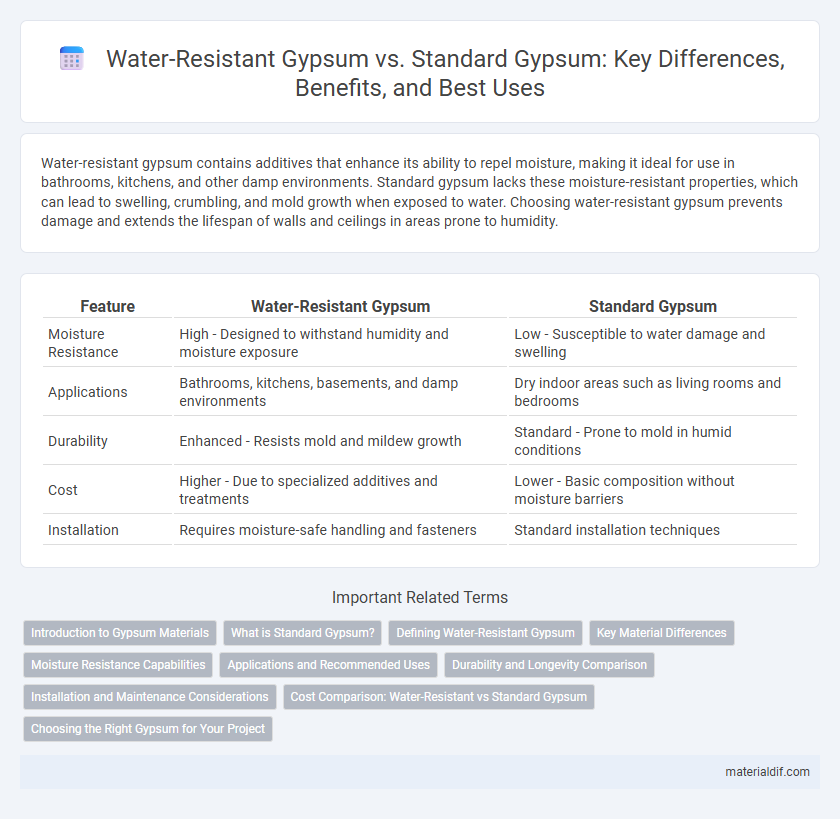Water-resistant gypsum contains additives that enhance its ability to repel moisture, making it ideal for use in bathrooms, kitchens, and other damp environments. Standard gypsum lacks these moisture-resistant properties, which can lead to swelling, crumbling, and mold growth when exposed to water. Choosing water-resistant gypsum prevents damage and extends the lifespan of walls and ceilings in areas prone to humidity.
Table of Comparison
| Feature | Water-Resistant Gypsum | Standard Gypsum |
|---|---|---|
| Moisture Resistance | High - Designed to withstand humidity and moisture exposure | Low - Susceptible to water damage and swelling |
| Applications | Bathrooms, kitchens, basements, and damp environments | Dry indoor areas such as living rooms and bedrooms |
| Durability | Enhanced - Resists mold and mildew growth | Standard - Prone to mold in humid conditions |
| Cost | Higher - Due to specialized additives and treatments | Lower - Basic composition without moisture barriers |
| Installation | Requires moisture-safe handling and fasteners | Standard installation techniques |
Introduction to Gypsum Materials
Water-resistant gypsum contains additives such as waxes or silicone to prevent moisture absorption, making it ideal for high-humidity environments like bathrooms and kitchens. Standard gypsum, primarily composed of calcium sulfate dihydrate, offers excellent fire resistance and soundproofing but lacks water repellency, leading to deterioration in damp conditions. Selecting the appropriate gypsum material based on moisture exposure enhances durability and structural integrity in construction applications.
What is Standard Gypsum?
Standard gypsum, also known as regular gypsum board, is a commonly used building material composed primarily of calcium sulfate dihydrate sandwiched between two paper layers. It offers moderate resistance to fire and sound but lacks moisture resistance, making it unsuitable for areas prone to water exposure. Compared to water-resistant gypsum, standard gypsum is more vulnerable to mold and deterioration when exposed to humidity or water.
Defining Water-Resistant Gypsum
Water-resistant gypsum is engineered with additives that enhance moisture resistance, making it ideal for humid environments and areas prone to water exposure. This specialized gypsum maintains structural integrity and prevents mold growth, unlike standard gypsum which absorbs moisture and deteriorates over time. Its applications include bathrooms, kitchens, and basements where enhanced durability against water damage is essential.
Key Material Differences
Water-resistant gypsum contains special additives like latex or silicone to repel moisture, while standard gypsum lacks these compounds, making it more susceptible to water damage. Gypsum core density in water-resistant variants is typically higher to reduce water absorption, enhancing durability in humid environments. Fiberglass mesh or other reinforcing fibers are often integrated into water-resistant gypsum to improve structural integrity compared to standard gypsum boards.
Moisture Resistance Capabilities
Water-resistant gypsum contains additives such as wax or silicone that significantly reduce water absorption, making it ideal for high-humidity areas like bathrooms and kitchens. Standard gypsum lacks these moisture-resistant properties, often leading to swelling, sagging, or mold growth when exposed to damp conditions. The enhanced moisture resistance capabilities of water-resistant gypsum extend the durability and maintain the structural integrity of interior walls and ceilings in moisture-prone environments.
Applications and Recommended Uses
Water-resistant gypsum is designed for environments with high humidity, making it ideal for bathrooms, kitchens, basements, and laundry rooms where moisture exposure is frequent. Standard gypsum, while suitable for dry, interior walls and ceilings, lacks the necessary additives to prevent mold and deterioration in damp conditions. For optimal performance and durability in moisture-prone areas, water-resistant gypsum boards are the recommended choice due to their enhanced resistance to water absorption and fungal growth.
Durability and Longevity Comparison
Water-resistant gypsum contains additives like polymers and waxes that significantly enhance its durability by preventing moisture absorption, making it ideal for high-humidity environments such as bathrooms and kitchens. Standard gypsum, without these additives, absorbs water easily, leading to faster degradation, swelling, and reduced longevity. Over time, water-resistant gypsum maintains structural integrity and aesthetic quality far better than standard gypsum in wet or damp conditions.
Installation and Maintenance Considerations
Water-resistant gypsum features enhanced moisture barriers that simplify installation in damp environments, reducing the risk of mold and mildew growth compared to standard gypsum. Standard gypsum requires careful handling and additional sealing measures during installation to prevent water damage and structural degradation. Maintenance of water-resistant gypsum involves routine inspections but generally demands less frequent repairs, enhancing longevity in high-humidity areas.
Cost Comparison: Water-Resistant vs Standard Gypsum
Water-resistant gypsum typically costs 20-30% more than standard gypsum due to its specialized additives and moisture-resistant properties. While the initial investment is higher, water-resistant gypsum reduces long-term repair and maintenance expenses in humid or wet environments. Standard gypsum remains a more budget-friendly option for dry areas where moisture exposure is minimal.
Choosing the Right Gypsum for Your Project
Water-resistant gypsum contains additives like fiberglass or wax to protect against moisture, making it ideal for high-humidity areas such as bathrooms and kitchens. Standard gypsum, while cost-effective and easy to install, lacks moisture resistance and is best suited for dry environments like living rooms and bedrooms. Selecting the right type of gypsum depends on the specific moisture exposure and durability requirements of your project to ensure long-lasting performance.
Water-resistant gypsum vs Standard gypsum Infographic

 materialdif.com
materialdif.com